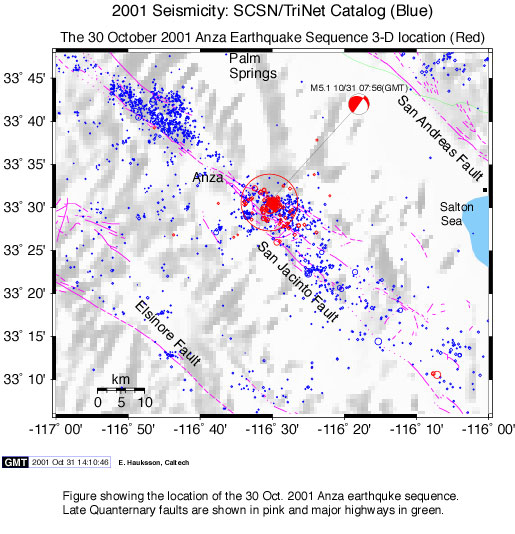

M5.1 Anza Earthquake of October 30, 2001
(Preliminary Report from : Southern California Seismic Network/TriNet)
Egill Hauksson and Kate Hutton, Caltech, Pasadena, CA91125
Lucy Jones and Doug Given USGS, Pasadena, CA 91106
jones@usgs.gov
10/31/2001
A M5.1 earthquake occurred at 11:56 p.m., October 30, 2001 10 miles
southeast of the town of Anza in northern San Diego County. It was
located within the 5 km wide San Jacinto fault zone, a member of the San
Andreas fault system, at a depth of 15 km (10 miles). The earthquake
occurred in the middle of the 60 km long Anza seismic gap that has not
experienced a major earthquake since 1895 and most likely before 1850.
The geologic slip rates of the San Jacinto fault are 10 to 15 mm/yr,
thus making its slip rate only second to the slip rate (25 to 35 mm/yr)
of the San Andreas fault.

The earthquake focal mechanism exhibited mixed left-lateral strike-slip and thrust motion on a vertical fault striking N35°E. This trend that is orthogonal to the strike of the San Jacinto fault suggests that the earthquake occurred on a restraining bend in the San Jacinto fault zone. Such geometrical complexities (bends) inhibit the movement on the main fault strand that shows strike-slip motion and strikes northwest. The aftershocks also show a northeast trend and mostly occur in the depth range of 13 to 16 km, extending over a zone about 4 km wide.
The San Jacinto fault is historically the most active in southern California. This is the nineteenth event of M5 or larger to have occurred on the fault in the last century. Most other parts of the San Jacinto fault ruptured in large earthquakes 1890, 1899, 1918, and 1923, except for the Anza gap and the segment that extends across Riverside. The location of this earthquake was just south of the February 25, 1980 M5.5 Whitewash earthquake. It is also just north of the 1937 earthquake of M5.9. The most recent large earthquake to occur on the San Jacinto fault was the Mw6.6 1986 Superstition Hill earthquake.
The earthquake activity of the last two months is high but not unprecedented in the seismic history of the southern California, including the Los Angeles basin. One possible interpretation of this earthquake activity is the emergence of southern California from the stress release shadow of the 1992 Mw7.3 Landers earthquake and Mw6.7 Northridge earthquakes. The Landers earthquake released stress across the whole region, including the Los Angeles basin. This year, the tectonic stress in the region may have increased to previous levels as demonstrated by the onset of normal level of background seismicity.